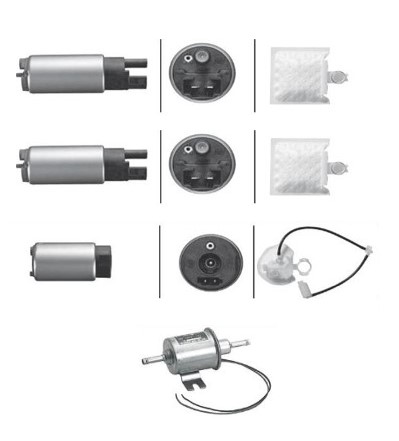
One of the most crucial components for the proper functioning of our vehicle is the fuel pump. Without it, the vehicle cannot start, as it is responsible for ensuring that the fuel injection system receives the necessary fuel for ignition.
The fuel pump is responsible for maintaining an almost constant fuel pressure, controlled by a pressure regulator, to ensure a continuous supply of fuel to the fuel delivery system.
FUEL PUMPS TYPES
Currently, vehicles use electric fuel pumps, whether external or internal..
We find electric in-tank pumps installed in or around the gasoline tank. They operate at a voltage of 12V and are activated by means of a relay. The air-fuel mixture is carried out in the intake manifold, and the pump starts operating when it receives the current, rotating to draw fuel and send it to the injector body.

FUEL PUMPS FAILURE
The lifespan of the fuel pump depends largely on the quality of the fuel used, but what causes the most damage is driving repeatedly with the tank nearly empty or in reserve. It also fails due to not changing the filters at the intervals specified by the manufacturer for maintenance. Among the most common failures are:
– Fuel low Pressure. In this case, the vehicle will not start because the engine requires a minimum pressure in the injector rail for them to supply fuel to the inside of the cylinders.
– Dirt. When there is dirt in the filter located before the pump, it won't be able to draw the necessary fuel to maintain a constant pressure in the rail, so we will notice jerks when idling and also when accelerating.
– Clogged Pump. The pump can be clogged or constricted, and as a result, we will notice an intermittent noise similar to the revving of an electric motor and experience engine misfires.
– Electrical Contact. When the electrical contacts are not functioning optimally, they may at times fail to provide the necessary voltage for the pump's operation, or it could also be that the relay activating it is beginning to malfunction. We will know this because the car sometimes starts perfectly, and other times it does not.
– Cooling. One of the reasons why the fuel pump in most vehicles is installed inside the fuel tank is to keep it cooled, as the fuel maintains it at an optimal temperature for operation. If we drive with the gasoline tank very low, it will affect this cooling capacity of the pump and may damage it.
The fuel pump could last almost the entire lifespan of the vehicle, but for that to happen, we need to perform proper maintenance of the filters and avoid driving with the tank in reserve. These are simple precautions that will save us time and money.